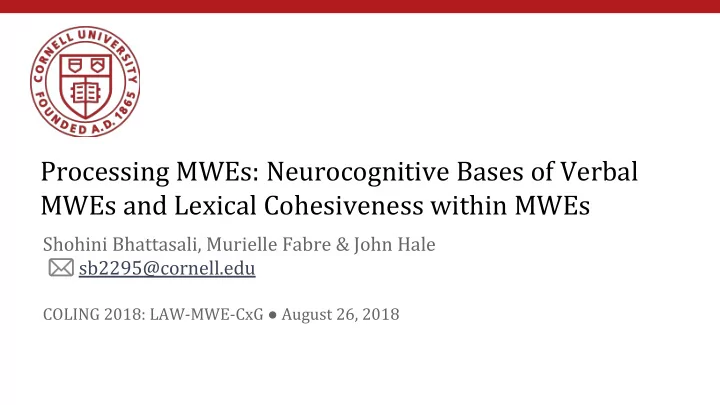

Processing MWEs: Neurocognitive Bases of Verbal MWEs and Lexical Cohesiveness within MWEs Shohini Bhattasali, Murielle Fabre & John Hale sb2295@cornell.edu COLING 2018: LAW-MWE-CxG ● August 26, 2018
Cornell University Introduction • Human study of natural language comprehension • Brain basis or areas that correspond to different aspects of MWE comprehension • Present neuroimaging study using fMRI
Cornell University Introduction • Use text attributes, correlate to real-time speech events and map them to observable brain processes “Once when I was six years old, I saw a magnificent picture … ”
Cornell University Introduction • Natural language comprehension relies on at least two cognitive processes: – Retrieval of memorized elements – Structural composition • MWEs like break the ice , boa constrictor, safe and sound , see to it, in spite of can help us address the neural correlates of these processes. • However, MWEs are a heterogeneous family of word clusters.
Cornell University Roadmap • Introduction ➤ Research Questions • Background • fMRI experiment • Results • Conclusion
Cornell University Research Questions Research Question 1: Do MWEs with different levels of cohesiveness correspond to different brain areas?
Cornell University Research Questions Research Question 2: Does comprehension of verbal MWEs implicate separate brain areas from non-verbal MWEs?
Cornell University Roadmap • Introduction • Research Questions ➤ Background • fMRI experiment • Results • Conclusion
Cornell University Background • Psycholinguistic studies have shown that MWEs are produced and understood faster than matched control phrases due to their frequency, familiarity, and predictability (Siyanova-Chanturia and Martinez, 2014) • Eg. bride and groom vs. groom and bride salt and pepper vs. pepper and salt (Siyanova-Chanturia et al., 2011)
Cornell University Background • MWEs span across different grammatical categories • Our dataset: 56% verbal MWEs; verbal idioms, verb participle constructions, light verb constructions, verb nominal constructions etc (1) You must see to it that you regularly pull out the baobabs as soon as they can be told apart from the rose bushes to which they look very similar to when they are young. (2) “ Good morning ”, said the little prince politely, who then turned around, but saw nothing.
Cornell University Background • AM such as Pointwise Mutual Information (PMI; Church & Hanks 1990) can be used to capture the varying degrees of compositionality within MWEs: • MWEs that receive a higher PMI score are seen as lexically more cohesive, which is interpreted as more noncompositional (less compositional)
Cornell University Background
Cornell University Background In summary: • MWEs are processed differently from other phrases • Can be distinguished based on grammatical category • Their compositionality can be quantified with a metric like PMI
Cornell University Roadmap • Introduction • Research Questions • Background ➤ fMRI experiment • Results • Conclusion
Cornell University fMRI Experiment Dataset: ● The audio stimulus was Antoine de Saint-Exupery’s The Little Prince , translated by David Wilkinson and read by Nadine Eckert-Boulet. ● 742 MWEs were identified using a transition-based MWE analyzer (Al Saied et al., 2017) trained on Children’s Book Test dataset (Hill et al., 2015).
Cornell University fMRI Experiment Dataset: ● PMI scores based on corpus frequency counts from the Corpus of Contemporary English (Davies, 2008) , and were calculated using mwetoolkit (Ramisch et al., 2010; Ramisch, 2012). ● The Stanford POS tagger and the NLTK POS tagger were used to annotate the words within the MWEs with their grammatical categories (Bird and Loper, 2004; Manning et al., 2014)
Cornell University fMRI Experiment Experimental Design: ● Participants (n=51, 32 female) were college-aged, right-handed, native English speakers ● Listened to The Little Prince ’s audiobook for 1 hour 38 minutes across nine sections. (15,388 words total) ● Comprehension was confirmed through multiple-choice questions (90% accuracy, SD 3.7%).
Cornell University fMRI Experiment Statistical Analysis: • The General Linear Model (GLM) typically used in fMRI data analysis is a time series linear regression (Poldrack et al., 2011) . F
Cornell University fMRI Experiment Analysis 1: Cohesiveness within MWEs Analysis 2: Verbal vs Non-verbal MWEs ❏ 742 MWEs annotated with PMI scores ❏ Verbal MWEs: 416/742 MWEs (56%) ❏ Word rate ❏ Non-verbal MWEs: 326/742 (44%) ❏ Bottom-up parser action count ❏ Word rate ❏ Word frequency ❏ Bottom-up parser action count ❏ Intonation (Pitch) ❏ Word frequency ❏ Acoustic Intensity (Volume) ❏ Intonation (Pitch) ❏ Acoustic Intensity (Volume)
Cornell University Roadmap • Introduction • Research Questions • Background • fMRI experiment ➤ Results • Conclusion
Cornell University Results Group-level results for Lexical Cohesion with MWEs: • Increasing cohesiveness, as seen through positive activation with PMI (in purple), elicits the Precuneus and Supplementary Motor Area • Decreasing cohesiveness, as seen through negative activation with PMI (in orange), correlates with activity in well-known nodes of the language network, such as Broca’s area and the posterior Temporal Gyrus.
Cornell University Results Group-level results for Verbal MWEs vs Non-verbal MWEs: • Verbal MWEs appear right-lateralized compared to non-verbal ones in IPL and in IFG triangularis. • Non-verbal MWEs yielded a wider pattern of activation, including bilateral Supramarginal Gyrus extending to STG and right SMA.
Cornell University Roadmap • Introduction • Research Questions • Background • fMRI experiment • Results ➤ Conclusion
Cornell University Conclusion • Provide neuroimaging evidence to illustrate that MWEs can be distinguished based on two different aspects: – Cohesiveness – Grammatical category: Verbal vs Non-verbal
Cornell University Conclusion • Repurpose PMI as an association measure to describe MWEs in terms of cohesion – shows that it is a cognitively informative metric to model cohesiveness and compositionality within word clusters in natural language.
Thank you!
Recommend
More recommend